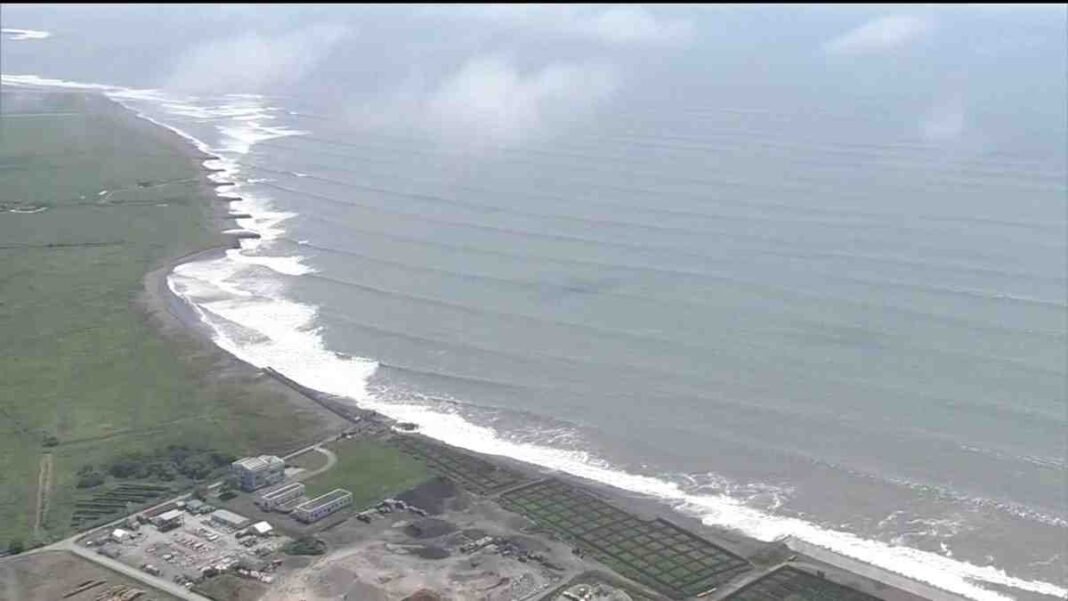A massive 8.8-magnitude undersea earthquake struck off the coast of Russia’s Far Eastern Kamchatka Peninsula early Wednesday, setting off tsunami waves up to four metres high and prompting widespread evacuations and alerts across the Pacific region.
The tremor, which the US Geological Survey (USGS) initially recorded as 8.0 before upgrading it to 8.8, occurred at a shallow depth of 19.3 kilometres. Its epicentre was located about 125 kilometres southeast of Petropavlovsk-Kamchatsky, a major coastal city with around 165,000 residents.
The powerful quake triggered tsunami waves that struck parts of Kamchatka and the Kuril Islands. Russia’s Emergency Ministry reported that waves between three and four metres were observed shortly after the earthquake, and buildings in several areas suffered damage. However, no fatalities or serious injuries have been reported so far.
Russia’s regional emergency minister, Lebedev, urged residents to move away from coastal areas immediately, warning that more waves could follow. “All need to move away from water peaks,” he stated, as emergency protocols were activated across the region.
Widespread Pacific Alerts
The United States Tsunami Warning System issued alerts for hazardous tsunami waves expected to affect several countries bordering the Pacific Ocean within a few hours of the quake. The advisory predicted waves more than three metres high along parts of Russia’s Pacific coastline and the northwestern Hawaiian Islands.
The tsunami warning extended to many Pacific nations, including Japan, the Philippines, Palau, and Micronesia. Waves between 0.3 and 1 metre were anticipated in coastal areas of the Philippines, Palau, the Marshall Islands, Chuuk, and Kosrae. South Korea, North Korea, and Taiwan were also expected to experience minor wave activity, less than 0.3 metres.
In Japan, the Meteorological Agency forecast waves of up to one metre across large portions of the country’s eastern coast. The agency later confirmed that a 50-centimetre tsunami had been recorded at Ishinomaki port in Miyagi Prefecture, while several other locations reported wave heights of up to 40 centimetres as the disturbance moved southward along the Pacific coast.
Prime Minister Shigeru Ishiba was promptly briefed on the developments. In response, an emergency coordination committee was set up to oversee Japan’s readiness and evacuation efforts.
Strong Aftershock Adds to Concerns
Roughly an hour after the initial quake, a powerful aftershock measuring 6.9 struck approximately 147 kilometres southeast of Petropavlovsk-Kamchatsky, at a depth of only 10 kilometres. While no injuries were reported, the additional tremor raised concerns about structural integrity in already-affected areas.
Kamchatka Governor Vladimir Solodov addressed the public through a video message on Telegram, describing the earthquake as “the strongest in decades of tremors.” He confirmed minor damage to infrastructure, including a local kindergarten, but reassured that no casualties had occurred.
In Severo-Kurilsk, a town in the Sakhalin region, authorities initiated evacuations as a precautionary measure. Governor Valery Limarenko stated that residents were being safely relocated from coastal zones amid fears of more powerful waves.
Recent Seismic Unrest in the Region
Wednesday’s earthquake follows a series of seismic disturbances recorded near Kamchatka earlier in July. At least five significant tremors were noted, the strongest of which was a 7.4-magnitude quake, also located offshore near Petropavlovsk-Kamchatsky at a depth of 20 kilometres.
The Kamchatka Peninsula is situated along the volatile Pacific Ring of Fire, one of the most tectonically active regions on the planet. Earthquakes are common in this zone due to frequent interactions between the Pacific and North American tectonic plates.
Historically, the region has experienced catastrophic seismic events. One of the most notable was the 9.0-magnitude quake on November 4, 1952, which triggered tsunami waves as high as 9.1 metres in Hawaii, though fortunately, it did not result in any fatalities.
Vigilance Continues as Pacific Braces for Aftereffects
Emergency teams and monitoring agencies across the Pacific Rim continue to assess the ongoing threat. The USGS and Pacific Tsunami Warning Center are closely observing aftershock patterns and potential secondary tsunamis, while governments in affected regions are maintaining high alert.
As of now, authorities stress the importance of staying away from coastlines and following evacuation orders where applicable. With no reported casualties, swift action by local and international agencies has so far helped avoid a humanitarian disaster.
However, continued vigilance remains essential as the region grapples with aftershocks and the broader impact of this major seismic event.








